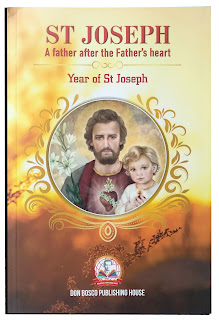A Coming Christ in Advent (Book Review)
Raymond E. Brown, A
Coming Christ in Advent, Minnesota :
The Liturgical Press, 1988, ISBN 0-8146-1587-2, pp. 71, $3.95.
Advent is a season of preparation for the coming of Christ.
In this book the author takes a look at the first chapters of Matthew and Luke
and draws reflections that enable the reader to enter deeper into the text and
consequently deeper into the mystery of Christ. These initial chapters contain
the long historical preparation for the coming of Christ in the history of Israel . Both
Matthew and Luke allude to the historical developments leading up to Christ’s
birth. Their views of history find expression through their narratives and are
doctored to suit their readers, keeping in mind their context and background.
Therefore, the first chapter of Matthew and Luke don’t only tell us about the
events around Jesus’ birth but also unearth the story of Israel which
lies beneath.
 The first chapter delineates the origin and purpose of the
infancy narratives and thus sets the foundation for what is to follow. The
author stresses that similarity of facts is not as important as similarity of
religious message. Matthew and Luke differ in a number of details, for example,
Matthew cites
The first chapter delineates the origin and purpose of the
infancy narratives and thus sets the foundation for what is to follow. The
author stresses that similarity of facts is not as important as similarity of
religious message. Matthew and Luke differ in a number of details, for example,
Matthew cites
The second chapter is a reflection on the genealogy of Jesus
as given in the gospel according to Matthew. The author bemoans the subtle
neglect of the genealogy on account of its not having much bearing on the
faith. He insists that such thinking is erroneous and that the genealogy
contains the essential theology of the Old and New Testaments. He divides the
genealogy into three parts: Patriarchs, Kings and Unknown and Unexpected
persons. The section on the Patriarchs begins with Abraham and ends with Jesse.
The distinctive character of this section is the choice of one son over
another. Isaac was chosen over Ishmael, Jacob over Esau and Judah over his
brothers. This pattern indicates to us God’s plan. The best weren’t always the
ones chosen. The genealogy of Jesus contains both sinners and saints. The
section on the Kings reveals the rise of monarchy and its ignoble end in exile.
The third section reveals to us God’s grace that works through the unimportant
and forgettable. There is also a theological import for the inclusion of the names of five women, all of
whom had a marital history of scandal or scorn.
The third chapter deals with the Annunciation to Joseph.
Matthew doesn’t report the annunciation to Mary. In this chapter the author
throws light on the situation of Joseph. He uses a realistic approach and
carefully avoids the spiritual vein which is often highlighted. He indicates
the role of Joseph and his relation to the Christ-child. The fourth chapter marks
a transition from Matthew to Luke. The author first presents the structure and
function of the first chapter of Luke and takes a brief look at each of the
special components like the angel Gabriel, Zechariah and Elizabeth. This
infancy narrative acts as a bridge between the Law and the Prophets, and the time
of Jesus. Parallels are drawn to emphasize this point.
The fifth chapter focuses on the Lucan canticles, the
Benedictus in particular. The origin and meaning behind the canticles is
lucidly indicated. The Benedictus is presented as a hymn that reveals early
Jewish-Christian Christology. The final chapter can be considered dedicated to
Mary for it deals with the Annunciation, Visitation and Magnificat. The author
presents his exegesis of the texts and draws some wonderful insights.
The book is exceptionally well-written and has the capacity
to inspire. The author proves his erudition in the scriptures and shows himself
to be insightful. His insights, although they may seem pretty commonplace
today, must have been startling when he first proposed them. The book is
especially useful to preachers but has beneficial material for every Christian.
Those looking to prepare themselves internally for Advent would find Brown’s
insights to be helpful.



Comments
Post a Comment